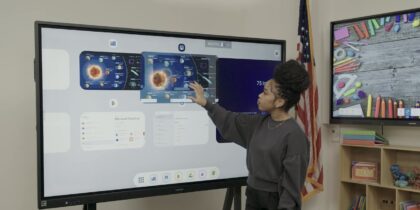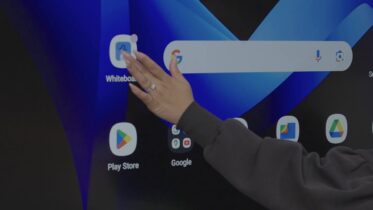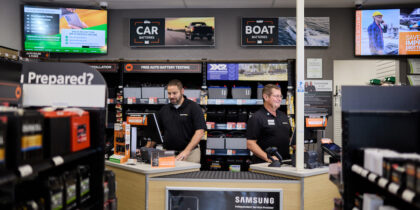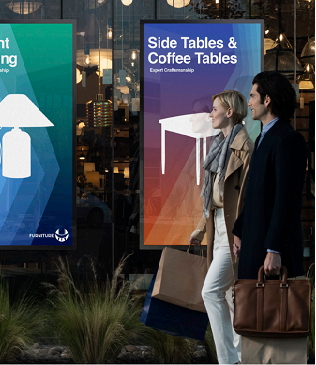The omnichannel world has created new avenues to engage shoppers before they even set foot inside a store. However, many brick-and-mortar retailers are still employing 20th-century tactics in their storefronts, such as static posters that don’t speak to the digital native generation. The answer could lie in the introduction of interactive storefront technology, integrating digital displays and sensors that can help draw shoppers in and build deeper loyalty for the brand.
Digital signage has become a mission-critical component of retailers’ customer engagement strategies. Early versions, or “digital signage 1.0,” were often digital displays playing looped content that reinforced a brand promise or overall store image. With the advance in LCD display and cloud-based content management systems, the industry has entered the current “2.0” era of digital signage, where thousands of screens across hundreds of locations can be remotely updated with dynamic, targeted messaging, achieving greater brand consistency and significant cost savings. This has enabled digital signage to gain significant traction with national retail chains, and it is helping the global digital signage marketplace to reach an expected $20.03 billion in revenue by 2020, according to a 2014 report from Grand View Research.
Next-Generation Customer Engagement
The next-generation of customer engagement takes this even further by introducing true interactivity that provides retailers the ability to connect with shoppers as they cross the store threshold. It’s been called “digital signage 3.0,” “next-generation engagement” or even “the digital revolution.” Call it whatever you want, as long as the purpose remains clear: Retailers must embrace interactive digital signage tools to connect with shoppers in ways that will influence their purchase decision and increase their brand loyalty.
“One of the biggest challenges retailers have been getting traffic inside of the retail store,” said Tom Nix, CEO of Scala, in a recent interview. “A large part of enticing people comes from what’s communicated within proximity to the shop window.” This means retailers need to find creative ways to take the store window and create more entertainment. They must entice shoppers to pay attention and learn more about the brand’s story. This often requires combining digital sources with various sensory elements, which is the foundation of digital signage 3.0. “It is not just video, but a combination of 21st-century tools that can draw people in,” Nix said.
Interactive digital signage holds strong promise for the retail industry. With device-driven shoppers converting at 40 percent higher rates, according to a 2014 study by Deloitte, retailers are blending more personal tools to enhance storefront engagement. Whether brands incorporate the use of personal mobile devices or social media, such as active Twitter feeds on signs, digital signage 3.0 is clearly becoming a critical part of the new path to purchase.
Tools of the Trade
In addition to consumer technology, retailers are tapping various engagement tools to bolster digital signage efforts. The following can all help drive storefront customer engagement:
- Gesture and Touch Technology. When retailers want to reach a select group of shoppers, or even better, a single shopper, they need a solution that delivers a personalized experience. Gesture and touch technology can deliver this by allowing shoppers to engage in a self-directed way. The retailer can then measure and monitor these small shopper samples. “Gesture technology is more of a discovery path,” Nix said. “It can be a great way for a brand to build on their overall value proposition to consumers.” For example, according to InStyle, Bloomingdale’s recently put this theory to the test with its interactive storefront windows. Featured in its flagship store in New York City, six interactive window displays featuring Ralph Lauren apparel invited passing shoppers to use a touchscreen to browse color samples. As their desired colored shirt, pants or accessories appeared, they could text “POLO” for a link to a checkout page.
- Virtual Greeters. Innovative retailers are combining digital signage with interactive platforms, creating next-generation digital signs or virtual assistants designed to bring messages to life. While some virtual greeters take the form of a holographic human, others can be simple interfaces displayed on interactive digital signs. The best examples often hit on three sensory aspects: sight, sound and motion. However, not all virtual greeters have to be complex. A new Scala customer engagement solution focuses on coffee shops and beacons, using an application that allows visitors to place an order via mobile devices, and then see its progress through an in-store digital screen. Shoppers who place their order via the application can take a selfie, which is then sent to the retailer. When guests are in the vicinity of the café, the order is pushed to a barista via geo-fencing technology, and then the barista fixes the beverage. As shoppers enter the café, they check in at a tablet that acts as a virtual greeter, which displays their face and the status of their purchase. Baristas can use the selfie to identify the customer and deliver the order. The concept creates a seamless experience and generates personalized customer engagement.
- Next-Generation Retail Digital Signage. As the industry moves to digital signage 3.0, retailers are creating a truly sensory experience with digital at the core of the process. The aforementioned café solution can be further enhanced by infusing scents into an already sensory experience. Scent machines, connected to the digital signage platform, are triggered by a motion-detection system to deliver the scent of freshly brewed coffee as guests pass the digital screen. Companies selling fragrances, soaps and freshly baked goods have also deployed similar approaches. “While we can’t tie a specific return on investment, this technology is about the customer loyalty, creating a seamless experience and driving customer engagement,” Nix said.
Digital signage displays have also evolved to allow more effective deployment in bright, storefront environments. Samsung’s OMD Series Smart Signage, for example, was designed specifically for use in store windows and other high ambient light locations. In addition to providing high brightness and visibility, the displays feature Samsung’s Smart Signage Platform to enable content to play straight from the display and embedded Wi-Fi to simplify connectivity.
As the omnichannel experience becomes critical to entice consumers to enter a store, digital signage 3.0 plays a pivotal role in grabbing their attention. With an innovative, interactive storefront, retailers can encourage customers to learn more about the brand, which ultimately drives purchases and grabs ongoing loyalty.






